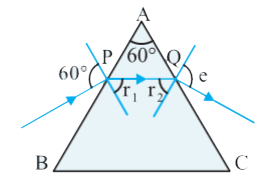A ray of light is incident at an angle of 60∘ on the face of a prism having refracting angle 30∘. The ray emerging out of the prism makes an angle 30∘ with the incident ray. Show that the emergent ray is perpendicular to the face through which it emerges.
To solve the problem, we will use the principles of refraction at the interface of the prism and apply Snell's law. Let's go through the solution step by step.
Step 1: Identify the given data
- Angle of incidence on the prism face, i1=60∘
- Refracting angle of the prism, A=30∘
- Angle between the emergent ray and the incident ray, δ=30∘
Step 2: Use the relationship involving the angles
We can use the formula that relates the angles in a prism:
δ=i1+i2−A
where:
- δ is the angle between the incident ray and the emergent ray,
- i1 is the angle of incidence,
- i2 is the angle of refraction inside the prism,
- A is the refracting angle of the prism.
Step 3: Substitute the known values into the formula
Substituting the known values into the equation:
30∘=60∘+i2−30∘
Step 4: Simplify the equation
Rearranging the equation gives:
30∘=60∘+i2−30∘
30∘=30∘+i2
Subtracting 30∘ from both sides:
0=i2
Step 5: Interpret the result
The result i2=0∘ indicates that the emergent ray is perpendicular to the face of the prism through which it emerges. This means that the angle of refraction at the second face of the prism is 0∘, confirming that the emergent ray exits perpendicular to the face.
Conclusion
Thus, we have shown that the emergent ray is indeed perpendicular to the face through which it emerges.
---
- Angle of incidence on the prism face, i1=60∘
- Refracting angle of the prism, A=30∘
- Angle between the emergent ray and the incident ray, δ=30∘
We can use the formula that relates the angles in a prism:
δ=i1+i2−A
where:
- δ is the angle between the incident ray and the emergent ray,
- i1 is the angle of incidence,
- i2 is the angle of refraction inside the prism,
- A is the refracting angle of the prism.
Substituting the known values into the equation:
30∘=60∘+i2−30∘
Rearranging the equation gives:
30∘=60∘+i2−30∘
30∘=30∘+i2
Subtracting 30∘ from both sides:
0=i2
The result i2=0∘ indicates that the emergent ray is perpendicular to the face of the prism through which it emerges. This means that the angle of refraction at the second face of the prism is 0∘, confirming that the emergent ray exits perpendicular to the face.
Thus, we have shown that the emergent ray is indeed perpendicular to the face through which it emerges.
Topper's Solved these Questions
- RAY OPTICS BOOK - VMC MODULES ENGLISHCHAPTER - RAY OPTICS EXERCISE - Example
21 Videos
- RAY OPTICS BOOK - VMC MODULES ENGLISHCHAPTER - RAY OPTICS EXERCISE - PRACTICE EXERCISE-1
1 Videos
- QUIZBOOK - VMC MODULES ENGLISHCHAPTER - QUIZEXERCISE - PHYSICS
30 Videos
- RAY OPTICS AND WAVE OPTICS BOOK - VMC MODULES ENGLISHCHAPTER - RAY OPTICS AND WAVE OPTICS EXERCISE - IMPECCABLE
58 Videos
Similar Questions
A ray of light is incident at an angle of 60∘ on one face of a prism of angle 30∘. The ray emerging out of the prism makes an angle of 30∘ with the incident ray. The emergent ray is
View SolutionA ray of light is incident at an angle of 60∘ on one face of a prism which has refracting angle of 30∘ . The ray emerging out of the prism makes an angle of 30∘ with the incident ray. If the refractive index of the material of the prism is μ=√a , find the value of a .
View Solution
Knowledge Check
A ray of light is incident at 60∘ on one face of a prism of angle 30∘ and the emergent ray makes 30∘ with the incident ray. The refractive index of the prism is
A1.732B1.414C1.5D1.33
A Ray of light is incident at an angle 60° on one face of a prism which has protecting angle of 30°. The emerging ray deviates through 30° from incident light. The refractive index of material of prism is
View SolutionA ray of light is incident on one face of a prism (m=√3) at an angle of 60∘. The refracting angle of the prism is also 60∘. Find the angle of emergence .

View SolutionA light ray is incident by grazing one of the face of a prism and after refraction ray does not emerge out, what should be the angle of prism while critical angle is C ?
View SolutionA ray of light is incident normally on one of the faces of a prism of apex angle 30 degree and refractive index √2. The angle of deviation of the ray in degrees is
View SolutionA ray of light is incident at 60∘ on one face of a prism of angle 30∘ and the emergent ray makes 30∘ with the incident ray. The refractive index of the prism is
View SolutionA ray of light is incident at 65∘ on one face of a prism of angle of 30∘ and the emergent ray makes 35∘ with the incident ray. The refractive index of the prism is:
View SolutionA ray of light incident at an angle 90° with the face of an equilateral prism passes symmetrically. Calculate the refractive index of the material of the prism
View Solution
